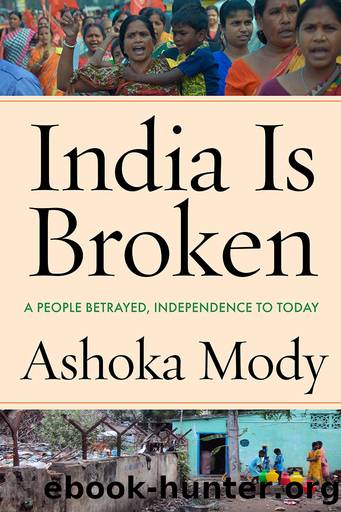India Is Broken by Mody Ashoka;

Author:Mody, Ashoka;
Language: eng
Format: epub
Publisher: Stanford University Press
Published: 2022-01-15T00:00:00+00:00
FIGURE 17.1: India gained global market share after the rupee devaluation.
Note: Indian rupee/US dollar exchange rate is the average of daily rates in the last week of December.
Source: UNCTAD Statistics, https://unctadstat.unctad.org/EN/Index.html and Global Financial Data.
FIGURE 17.2: Foreign investment: China got the factories, India got some cash.
Source: World Bank, World Development Indicators, BX.KLT.DINV.CD.WD and BX.KLT.DINV.CD.WD.
With the rupee floating, India was back from the financial edge into safe territory. Foreign investors saw India in a more favorable light. Coca-Cola returned in October 1993, sixteen years after it had left, having then rejected the Janata governmentâs demand to reveal the secret formula of its concentrate and refusing also to dilute its equity holdings in its Indian subsidiary. Coke reintroduced itself ostentatiously to Indians at a ceremony held at the Taj Mahal, the white-marbled monument to an emperorâs love for his queen.42
However, most foreign funds came as investments in the Indian stock market rather than as foreign direct investment in production ventures, like Coca-Cola. The contrast with China was striking (Figure 17.2). In 1996, China received $40 billion as foreign direct investment, the type where investors built and ran factories, whereas India received only $2.5 billion of direct investment that year. India, though, received $4 billion in speculative and volatile equity flows while China received negligible such amounts. China was a global manufacturing hub. India was a risky bet.
In May 1994, in the spirit of India-as-a-financial-bet, the U.S. investment bank Morgan Stanley opened an office in India. The rumor was that Naina Lal, one of Morgan Stanleyâs Indian executives, would receive an annual compensation of one crore (10 million) rupees, about $300,000, which was an unheard-of sum in the Indian context. The average Indian income in 1994 was about $345. While the Harshad Mehta scam had receded in memory as a blip, the euphoria of the Narasimha RaoâManmohan Singh liberalization continued in the financial sector, amplified by the gush of international capital seeking high returns in âemerging markets.â The economic merit of a rapidly expanding financial sector was questionable.43 As the towering Cambridge University economist Joan Robinson pithily said, finance must follow enterprise. The question for India was: would liberalization unleash enterprise?
The Limits and Dangers of âMe, Me, Meâ
The overall assessment of the Rao-Singh reforms, especially of their ability to generate jobs and reduce poverty, must wait until chapter 20. But there were several cautionary messages even in the early days.
Download
This site does not store any files on its server. We only index and link to content provided by other sites. Please contact the content providers to delete copyright contents if any and email us, we'll remove relevant links or contents immediately.
| Central Asia | Southeast Asia |
| China | Hong Kong |
| India | Japan |
| Korea | Pakistan |
| Philippines | Russia |
The Sympathizer by Viet Thanh Nguyen(4099)
The Rape of Nanking by Iris Chang(4025)
World without end by Ken Follett(3348)
Ants Among Elephants by Sujatha Gidla(3282)
Blood and Sand by Alex Von Tunzelmann(3061)
Japanese Design by Patricia J. Graham(3006)
City of Djinns: a year in Delhi by William Dalrymple(2438)
Foreign Devils on the Silk Road: The Search for the Lost Treasures of Central Asia by Peter Hopkirk(2389)
Inglorious Empire by Shashi Tharoor(2349)
The Queen of Nothing by Holly Black(2326)
India's Ancient Past by R.S. Sharma(2307)
In Order to Live: A North Korean Girl's Journey to Freedom by Yeonmi Park(2305)
Tokyo by Rob Goss(2295)
India's biggest cover-up by Dhar Anuj(2251)
Tokyo Geek's Guide: Manga, Anime, Gaming, Cosplay, Toys, Idols & More - The Ultimate Guide to Japan's Otaku Culture by Simone Gianni(2245)
The Great Game: On Secret Service in High Asia by Peter Hopkirk(2231)
Goodbye Madame Butterfly(2164)
Batik by Rudolf Smend(2010)
Living Silence in Burma by Christina Fink(1988)
